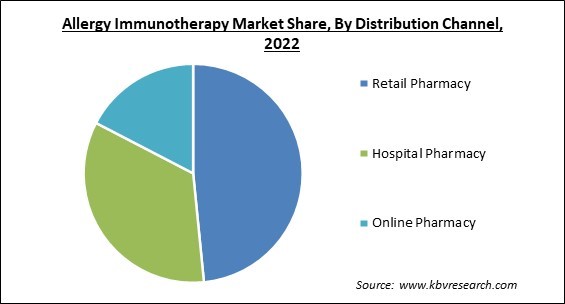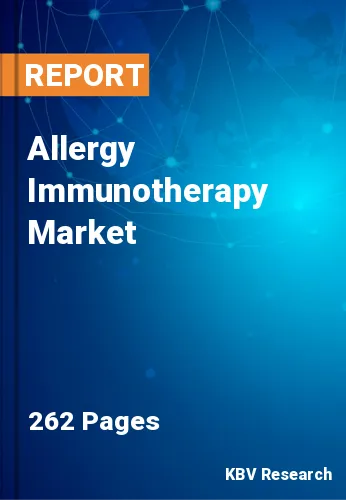The Global Allergy Immunotherapy Market size is expected to reach $2.9 billion by 2030, rising at a market growth of 8.4% CAGR during the forecast period.
Subcutaneous Immunotherapy is one of the popular and efficient types of allergy immunotherapy, which alters the immune system making it possible to stop the onset of new allergies and asthma attacks. Therefore, the Subcutaneous Immunotherapy segment is anticipated to capture more than 64% share of the market by 2030. By changing allergic disease by focusing on the underlying immunological process, subcutaneous immunotherapy (SCIT) is a novel treatment for allergic disease. Its effectiveness and safety have been proven in numerous controlled clinical trials for treating asthma, allergic rhinitis/rhino conjunctivitis, and hypersensitivity to stinging insects. An "allergy shot" is often referred to as subcutaneous immunotherapy (SCIT), provided by injection. It is the go-to treatment for allergen desensitization and offers symptomatic relief for asthma and allergic rhinitis sufferers. Some of the factors impacting the market are increased allergic disorder prevalence to drive market growth, advanced procedures are in high demand, and side effects and high cost.

The burden of allergic diseases, currently increasing prevalence, may be connected to the anticipated growth in wealth. Complex allergies' financial and medical impact on the healthcare system drives research & development in this field to develop new treatments. Throughout the anticipated period, there is potential for the growth of the market due to consumers' increasing disposable incomes and their capacity to spend more on allergy-related therapies. It is growing quickly. With rising environmental pollution, increased alcohol use, changes in dietary habits, and an increase in allergies connected to the skin, the market has experienced a boom in demand. Oral immunotherapy is becoming more well-known among patients and medical professionals, particularly for treating allergic rhinitis. For people with low tolerance to allergens, oral immunotherapy is primarily used to reduce the frequency of allergic reactions brought on by unintentional or accidental allergen exposure. For this reason, market participants are concentrating on enhancing their oral immunotherapy solutions. The market is expected to develop because of the growing demand for improved procedures and the rise in allergies.
However, depending on the nature & severity of the allergy, allergy immunotherapy lasts 3 to 5 years longer than traditional therapies. Due to ongoing financial difficulties, patients will likely cease receiving therapy in the middle of treatment. Due to this, the market will be hampered. Also, pregnant women with heart disease or severe asthma should not have allergy shots. The market will shrink as a result of high costs and numerous adverse effects. Furthermore, the COVID-19 pandemic severely impacted the global economy. Due to the strict lockdowns and stay-at-home guidelines implemented during the pandemic, patient visits decreased, negatively impacting the market. Additionally, the increased use of masks and restrictions on outdoor activities to prevent the spread of the COVID-19 infection had limited the patient's exposure to allergens, which in turn had an adverse effect on the patient population and the market's growth.
By distribution channel, the market is categorized into hospital pharmacy, retail pharmacy, and online pharmacy. In 2022, the retail pharmacy segment witnesses the largest revenue share in the market. Because these distribution channels offer convenience, exclusive savings, and high-quality customer service, an increase in the number of retail pharmacies and the patients who use them is projected to improve sales and lead to the segment's expansion. Further, the market is expanding in this segment as a result of the easy accessibility of these stores.

Under sublingual immunotherapy (SLIT) type, the market is further divided into tablets, and drops. The sublingual immunotherapy (SLIT) segment acquired a substantial revenue share in the market in 2022. SLIT is expected to become a crucial alternative for people who are unable to receive allergy injections. SLIT tablets have received FDA approval and are currently available in developing nations. The use of liquid formulation for therapeutic purposes is projected to become legal in the future. This would accelerate the development of the SLIT segment in the nation.
Under sublingual immunotherapy (SLIT) type, the market is further divided into tablets, and drops. In 2022, the tablets segment held the highest revenue share in the market. For instance, allergic rhinitis (hay fever) and allergic asthma are treated with sublingual immunotherapy (SLIT) tablets. Notably, SLIT tablets are particular to the allergens that cause the person's sensitivities. As a result, they are typically recommended based on the findings of allergy testing, which assists in identifying the specific allergens that are causing the patient's symptoms.
Based on allergy type, the market is classified into allergic rhinitis, allergic asthma, and others. In 2022, the allergic rhinitis segment registered the highest revenue share in the market. A diagnosis of allergic rhinitis is related to an array of symptoms that affect the nose. When someone inhales an allergen, such as dust, animal dander, or pollen, they experience these symptoms. An article from the NCBI 2022 claims that allergic rhinitis is as common as 30% of the population worldwide, although the frequency based on doctor diagnoses is closer to 15%.
| Report Attribute | Details |
|---|---|
| Market size value in 2022 | USD 1.5 Billion |
| Market size forecast in 2030 | USD 2.9 Billion |
| Base Year | 2022 |
| Historical Period | 2019 to 2021 |
| Forecast Period | 2023 to 2030 |
| Revenue Growth Rate | CAGR of 8.4% from 2023 to 2030 |
| Number of Pages | 262 |
| Number of Table | 420 |
| Report coverage | Market Trends, Revenue Estimation and Forecast, Segmentation Analysis, Regional and Country Breakdown, Companies Strategic Developments, Company Profiling |
| Segments covered | Treatment Type, Distribution Channel, Allergy Type, Region |
| Country scope | US, Canada, Mexico, Germany, UK, France, Russia, Spain, Italy, China, Japan, India, South Korea, Singapore, Malaysia, Brazil, Argentina, UAE, Saudi Arabia, South Africa, Nigeria |
| Growth Drivers |
|
| Restraints |
|
Region wise, the market is analyzed across North America, Europe, Asia Pacific, and LAMEA. In 2022, the Europe region led the market by generating highest revenue share in the market. Increased approvals of allergy drop in the Europe region also increase the region's share of the market. The adoption of allergy immunotherapy in Europe has been found to have important distinctions and synergies. There are differences in the creation, accessibility, and application of allergen extracts. The region's increasing pollution would be impacted by at least one type of allergy.
The market research report covers the analysis of key stakeholders of the market. Key companies profiled in the report include Viatris, Inc. (Mylan N.V.), Merck KGaA , NIOX Group plc , DMS Imaging SA, Adamis Pharmaceuticals Corporation, Stallergenes Greer International AG (B-Flexion), Allergy Therapeutics plc , DBV Technologies S.A., HAL Allergy B.V. (Droege International Group AG.), LETI Pharma, S.L.U.
Free Valuable Insights: Global Allergy Immunotherapy Market size to reach USD 2.9 Billion by 2030
By Distribution Channel
By Treatment Type
By Allergy Type
By Geography
This Market size is expected to reach $2.9 billion by 2030.
Advanced Procedures are in High Demand are driving the Market in coming years, however, Side Effects and High Cost restraints the growth of the Market.
Viatris, Inc. (Mylan N.V.), Merck KGaA , NIOX Group plc , DMS Imaging SA, Adamis Pharmaceuticals Corporation, Stallergenes Greer International AG (B-Flexion), Allergy Therapeutics plc , DBV Technologies S.A., HAL Allergy B.V. (Droege International Group AG.), LETI Pharma, S.L.U.
The expected CAGR of this Market is 8.4% from 2023 to 2030.
The Subcutaneous Immunotherapy (SCIT) segment is leading the Market by Treatment Type in 2022; thereby, achieving a market value of $1.9 billion by 2030.
The Europe region dominated the Market by Region in 2022, and would continue to be a dominant market till 2030; thereby, achieving a market value of $1.1 billion by 2030.
Our team of dedicated experts can provide you with attractive expansion opportunities for your business.

